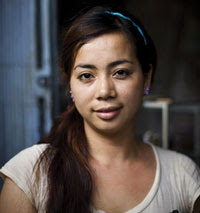via CAAI News Media
Wednesday, 31 March 2010 14:01 Nguon Sovan
SAVVY mobile phone customers continue to benefit from feverish competition among operators, and there are no signs of a slowdown meaning switching SIMs is still rampant.
“If we look back to before last year, when there were only a few mobile phone operators, when I needed a SIM card it cost more than US$10 and had to be filled with $5 to activate it,” Nguon Setha, a second-year student of English Literature at the University of Cambodia, recalled recently.
“Now, a SIM card is less than $1, or free of charge, and, more attractively, there is already credit on it to make calls.”
Now Nguon Setha has 20 SIM cards, but he only keeps one permanent number – his first.
“I still use the first one I had, because all my friends know it,” he said. “For the new cards, I just take the benefits from them, when the companies give them free or sell at quite cheap prices. And I use them to call out. After they run out of credit, I ditch them.”
This strategy has helped him reduce refill costs for the one phone he uses permanently.
“Before, I refilled $5 on my phone every month, but now it’s just once every three months,” he said.
The competitive incentives – free SIM cards, prizes, low tariffs and free minutes – have created other strategies for mobile phone users.
“I have bought around 15 SIM cards, but I use only two SIM cards that have good tariffs, good network coverage and which most of my friends are using,” said Sroeun Sreylis, a second-year business student at Norton University.
“Now, it’s quite cheap, the cost of a SIM cards and tariffs,” she said. “One minute used to cost more than $0.10, but now it’s cheaper, below $0.10, and sometimes with special promotions on in-network calls, and SMSs are free.”
She too said she uses SIM cards just long enough take advantage.
“Usually, for cross-network, the tariff is higher than for inside the network,” she said. “And some of my friends, they use another network, so I have to switch to their network when I call them.”
But do the promotions help the mobile phone operators?
Gary Foo, marketing manager at Hello, the fourth-ranked of nine companies, told the Post that competition has made it impossible to stand out, even if it means a loss of revenue.
“It’s obvious that it affects every operator’s [revenue], but we need to invest a little bit to get new customers in,” Foo said. “And the important thing is we have to maintain our existing customers with good offers and make customers loyal to our service.”
Hello has distributed more than 800,000 SIM cards so far, in a market of around five million mobile phone users, but Foo said he didn’t know how many users were active, although parent company Axiata reported in recent financial results it had 770,000 active users in the Kingdom by the end of last year.
“Normally for free or cheap promotional SIM cards, customers always want to try them,” he said. “But after that, they will consider and make comparisons about the service quality and tariff, so they will take whoever is to their satisfaction.”
Some customers do have many SIM cards, enjoying free or cheap prices, but they generally have one primary card, he said. “Our main focus is on the value to customers, and our service quality, to ensure smooth, non-interference connection calls.”
Promotions helped Beeline Cambodia, which entered the market in mid-2009, reach hundreds of thousands of subscribers. The company announced early this month it had exceeded 367,000 users, with revenue per user climbing.
Nhem Socheata, Beeline’s Cambodia spokesman, would not say how many SIM cards the company put out to reach that many users, but she said the firm had undertaken promotional campaigns with prizes, including a drawing for a new car.
Thomas Hundt, chief executive officer of Smart Mobile, also declined to put a number on the amount of SIM cards the company has distributed, but said it is gaining thousands of new subscribers each day.
“We are working on further enhancement and extension of our coverage, as well as additional products and services to be deployed in the course of 2010,” he told the Post.
“We are quite positive on our growth, and we plan to at least double the amount of users by the end of 2010,” he said, adding that new users were coming from the provinces and Phnom Penh alike.
“Most of [our users] are representatives of the young generation,” he said, “especially students, young professionals of the private and government sectors, but also small and big businesses as our corporate customers.”

























